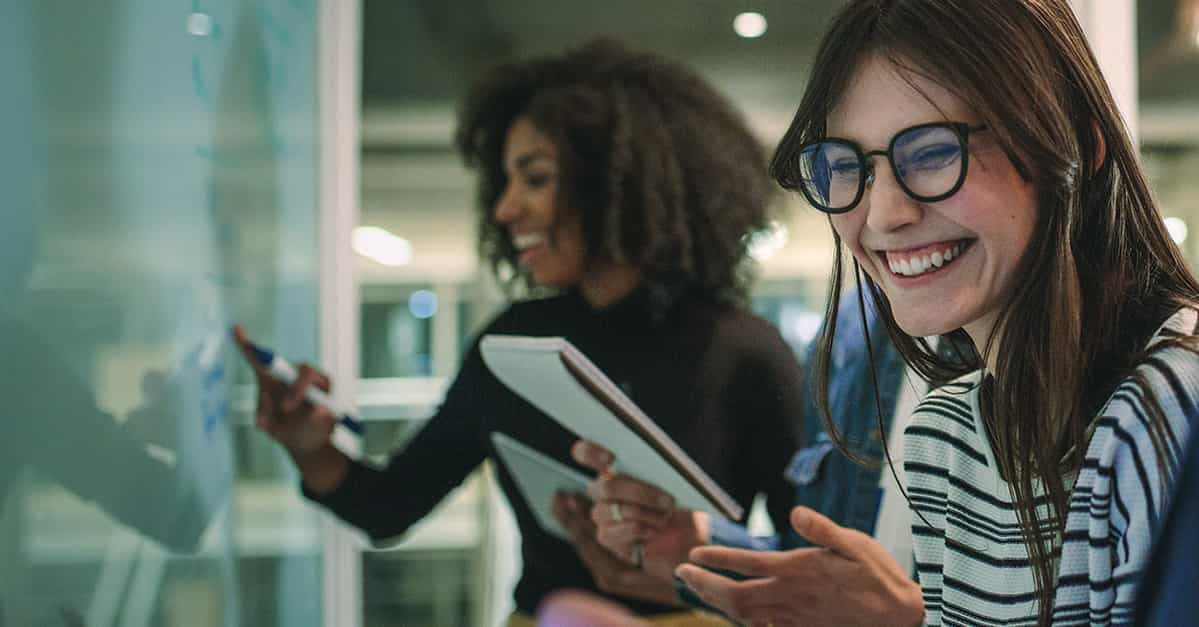15 active learning activities to energize your next college class

Posted by Tricia Whenham on Apr 2, 2020 6:00:00 AM
The evidence is clear — postsecondary students engage more, learn more and accomplish more with active learning. In one proof point, a meta-analysis from the Proceedings of the National Academy of Sciences found that student exam scores improved 6% when active learning approaches were used. And students in traditional classes were 1.5 times more likely to fail than those being taught with interactive methods.
Are you ready to move to a different way of teaching but need some ideas to get you started? Or maybe you’ve been running your courses this way for years but want ideas that work for hybrid and HyFlex learning. Whether your classes are in person, online or somewhere in between, here are 15 active learning activities to try with your students this semester.
1. Think-pair-repair
In this twist on think-pair-share, pose an open-ended question to your class and ask students to come up with their best answer. Next, pair learners up and get them to agree on a response. Get two pairs together, and the foursome needs to do the same thing. Continue until half the group goes head to head with the other half. If some of your students are online, breakout rooms in your conferencing software let you do the same thing virtually. Here’s how it works in Zoom.
2. Improv games
If your classroom is museum-level quiet no matter how you try to liven things up, try some low-stakes (read: not embarrassing) improv activities. In the three things in common game, pairs figure out the most unexpected things they share (this can also be done online in breakout rooms). Or challenge your students to count to 20 as a group with a different person saying each number — but no one is assigned a number, and if two people talk at the same time, everyone starts again at 1. (If some students are in the room and some remote, you’ll need full-room microphone pickup for this to work. Here’s how Nureva® audio can help.)
3. Brainwriting
You’ve probably tried brainstorming, but have you tried brainwriting? In this approach, students are given time to come up with their own ideas individually before sharing them out loud or posting them to an online whiteboard or other shared platform. Building in space for individual reflection leads to better ideas and less groupthink.

4. Jigsaw
Help students build accountability by teaching each other. Start by dividing them into “home groups” (four or five people works well). Again, breakout rooms in Zoom or Google Meet make this simple even if some people are remote. Assign each person in the group a different topic to explore — they’ll regroup to work with all the students from the other groups who are exploring the same idea. Once they’ve mastered the concept, students return to their home group and everyone shares newfound expertise.
5. Concept mapping
Collaborative concept mapping is a great way for students to step away from their individual perspectives. Groups can do this to review previous work, or it can help them map ideas for projects and assignments. You can cover classroom walls with sticky notes and chart paper or take advantage of online tools to map out connections between ideas.

6. The one-minute paper
How much could you explain in one minute? At the end of class, set a timer and ask students to record their most eye-opening revelation or biggest question. This activity lets students reflect on learning and build writing skills — plus, you’ll get a window into their understandings and misunderstandings. Here are more prompts you can use to get students writing.
7. Real-time reactions
When students are watching a video, a mini lecture or another student’s presentation, have them share their real-time reactions. This helps students spot trends and consider new points of view. You can set up a shared document for everyone to contribute to or simply use the chat function in your conferencing software.

8. Chain notes
Write several questions on pieces of paper and pass each to a student. The first student adds a response (use a timer to keep things moving quickly) and then passes the page along to gather more responses. Multiple contributions help build a more complete understanding. A digital alternative involves using shared documents that multiple students are invited to edit. Then your class can examine the responses and identify patterns and missing pieces.
9. Idea lineup
Choose a question that has a range of responses, and then ask students where they stand — literally. Have them come to the front of the classroom and organize themselves in a line, based on where on the spectrum of answers they find themselves. In a hybrid classroom, get them to place themselves on a virtual number line instead.
10. Mystery quotation
Test how well students can apply their understanding of an issue or a theoretical position. After they’ve explored a topic, show them a quotation about it they’ve never seen before. Their task is to figure out the point of view of the person behind the quotation — and justify it to the class. Students can debate this issue in small breakout groups before beginning a whole-class discussion.
11. Idea speed dating
Have students cycle through your space, or through breakout rooms in Zoom or Google Meet, sharing insights about a topic or their elevator pitch for an upcoming project. As they present their learnings multiple times on several “speed dates,” students’ presentation skills and perspectives will grow.

12. Peer review
The process of peer review is as old as academia, and it’s never too early to start. Have students swap drafts of their essays, proposals or lab reports, and then come up with comments and questions for each other. Make sure you’re clear about what the goals are (using rubrics helps). For example, students could identify compelling arguments, unanswered questions and holes in logic.
13. Quescussion
Ever played Jeopardy? Then you’re ready for quescussion. It’s like a standard class discussion but only questions are allowed (students call “Statement!” if someone slips up). If you play this game at the beginning of the course, the questions can help shape the rest of it. If you have students both in the room and calling in from a distance, make sure the remote learners get equal airtime and that your audio system is picking up students’ voices clearly.

14. Sketchnoting
Instead of taking traditional lecture notes, try getting your students to sketch a picture that represents what they’ve learned during class. Remember, it’s not about the quality of the art — it’s about how drawing prompts students to visualize their understanding and look at their learning from a different perspective.
15. Empathy mapping
Take a page from the designers’ handbook and get students to explore deeper by embracing a perspective. It’s deceptively simple — write down what a person says, thinks, does and feels. The ability to slow down and immerse yourself in another point of view is valuable. In design thinking, empathy maps help designers create better products for users. But this process can be just as valuable for analyzing characters from literature, historical figures or political stances.
Editor’s note: This post was originally published August 2018 and has been updated.

Posted by
Tricia Whenham
April 2, 2020

















